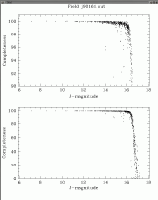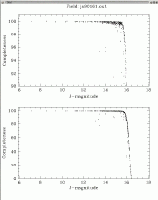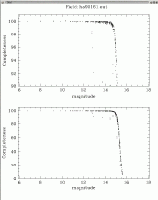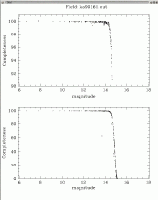 at J, H, and Ks,
respectively) to define the faint end of the faintest magnitude bin in each
waveband.
at J, H, and Ks,
respectively) to define the faint end of the faintest magnitude bin in each
waveband.
The Level 1 Specifications call for 99% completeness at galactic latitudes
more than 30° from the Plane. The specification indicates that
completeness be calculated "per magnitude in the faintest magnitude bin."
The 2MASS project has used the Level 1 sensitivity specification (15.8, 15.1,
and 14.3 mag for 10- at J, H, and Ks,
respectively) to define the faint end of the faintest magnitude bin in each
waveband.
at J, H, and Ks,
respectively) to define the faint end of the faintest magnitude bin in each
waveband.
Multiple observations of sources provide a direct means of characterizing completeness. The dataset which generated the All-Sky Release provides two estimates of completeness as a function of magnitude which derive from:
In both cases, the completeness of the entire Release dataset lies at or significantly fainter than the Level 1 requirements. Figures 1 and 2 illustrate examples of the completeness measure obtained by these two different methods. Table 1 summarizes the 99% completeness limits obtained from the repeated calibrations.

| 
|
| Figure 1 | Figure 2 |
| 16.1 | 15.5 | 15.1 |
The Level 1 requirements, however, apply to the 2MASS Catalog, rather than the entire dataset. The "2MASS Point Source Catalog" is a subset of the Release with higher photometric quality and reliability than the full dataset. Catalog-level sources are either those so bright that they saturate the 1.3 s Survey exposure, or those that receive photometric quality (ph_qual) of "A," indicating that a source has a signal-to-noise ratio AND a photometric uncertainty consistent with SNR=10. Thus, a source can suffer incompleteness in the Catalog, not because it went undetected by 2MASS, but because it lies at the Catalog threshold. Figures 3, 4, and 5 show the completeness for Catalog sources in each of the three Survey bands. The first row in Table 2 lists the 99% completeness magnitude threshold in each band. The second row of the table gives the magnitude of the faint end of a one-magnitude-wide bin for a mean completeness of 99% across the bin. Since completeness drops steeply faintward of the 99% completeness threshold, and since the completeness curves have similar shape in each band, the "binned" 99% completeness limit is consistently 0.3 mag fainter than the "differential" 99% completeness limit.

| 
| 
|
| Figure 3 J-band | Figure 4 H-band | Figure 5 Ks-band |
| 15.7 | 14.7 | 14.4 | differential |
| 16.0 | 15.0 | 14.7 | faint end of one-magnitude bins |
| 15.8 | 15.1 | 14.3 | Level 1 requirement |
Release completeness substantially exceeds specifications in all bands. "Catalog" completeness exceeds specification at J and Ks, but falls 0.1 mag short of the completeness specification at H-band (because a designated "Catalog" [i.e., ph_qual="A"] source at the completeness threshold gets a ph_qual="B" designation slightly more than 1 in 100 opportunities).
Note: The completeness specification focuses on the faint end of the 2MASS source flux distribution function, where declining sensitivity impacts competeness in a significant way. Implicit in the specification is that 2MASS is virtually 100% complete for brighter objects. This assertion is testable for stars as bright as magnitude 10, based on the figures above. Validating completeness for even brighter objects is a difficult prospect. Positive completeness tests have been made against visual bright star catalogs. Data do not exist to evaluate internal completeness for bright stars in the manner discussed above using the calibration fields. One source of bright star incompleteness involves a blind column in the 51 ms "Read_1" integrations (rd_flg='1') in the northern Ks-band array for the first portion of Survey operations. This effect has been documented in the "Point Source notes" Caveats section (I.6b). Both the completeness statistics of the Read_1 sources and the effects of the bad column are discussed here. Since stars missed in Ks-band were well photometered in J and H, in these instances the "Catalog" contains these sources.
[Last Updated: 2003 January 23; by M. Skrutskie]